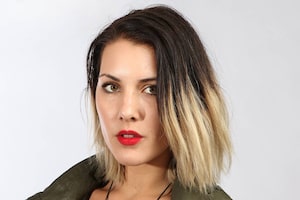Entertainer Kanye West also has his own fashion line.LUCAS JACKSON
Three big words informed most of last week's online punditry: metrosexual, black Lincoln. That's the phrase a Republican consulting firm, hired by American billionaire Joe Ricketts and the Super PAC he funds, came up with to define (and slander) Obama's presidential pretensions. What could be worse than a well-dressed president who's like a beloved national hero, except black? It's plain said that conservatives are still taking exception to blackness; it's almost as unsettling that liberals are making exceptions for it. Within minutes of the bizarrest Super PAC news ever, I read 20 variations on the tweet "dude, Metrosexual Black Lincoln sounds like the coolest guy ever," as though Obama were starring in a Melvin Van Peebles film.
Black metrosexuality (aside: If in 2008 I had known I would ever have to use that word again, I would not have become a writer) has been trending for years, and white moderates only think it's so cool because their norm is still Caucasian and straight (or at least straight-acting). This fetishization crosses party lines, making visible that which unites all white people, but liberals especially. Since the jazz-age hipsters, we have widely and shallowly associated "black" with "cool."
It's not malevolent, just racist. Attempts to get down with othered and thus mysteriously hip African-American cultures are a way to offload the anxieties about being bourgeois that only the bourgeois have.
Obamaphobia may rule the red states, but in blue-chip cities, homosexy Republican-a-likes appear with increasing frequency: The foppish style bloggers at Street Etiquette (streetetiquette.com), the dandy musicians Pharrell and Zebra Katz and Theophilus London, and the daddy of them all, Kanye West. (I did not believe the rumours West was gay until he started dating Kim Kardashian; I'm sorry, but that's just protesting too much.)
This runs contra the white-heritage trend, for stylish WASPs, of donning what's essentially butch drag. If you take a white bro out of his plaids and put him in a salmon-coloured suit, he'll feel lame and dated. Put it on a black man and the white bro will think the black guy looks rad. I have actually seen this happen, but I also believe it's true in a creeping, pervasive sense.
Take our chart-proved love for rap, even while rap gets poppier and less "black" all the time. Very concerned white people (hiiii) love debating whether the avant-rap group Odd Future is offensive or not, as defined by Tyler the Creator, that make-believe malefactor. But what's so odd about him, really? By playing on both our boredom and our old societal expectations of black boys, sans all the action, Tyler's just dull. Yes, he has written some absurdly gay-unfriendly lyrics, then tried to pass them off as jokes, but if they're not funny, they're also not particularly influential. Odd Future can't shock this way: If there is "hipster racism," the term recently bandied about in criticism of the HBO show Girls, Tyler's is a hipster homophobia.
Much more threatening to the conservative social order are the young black men don't dress "like thugs," who don't get stop-and-frisked, who, like millennial gays in J. Crew, can "pass." These guys aren't new in town: Before "gangster" style was sagging jeans and hoodies, it was cuffed slacks and fedoras. SoCal OGs in the sixties were as natty as the Rat Pack, which is what made them, to the then-norm, perversely frightening. Those we can't lock in demographic boxes might climb into the windows of our ivory towers at night.
Kehinde Wiley — who is black and gay and popular with fashion people — made his name portraiteering the contemporary equivalents, young black urban males in chill outfits more hip-hop than hip.
His characters are photographed, then painted with latent eroticism against lavish, regal backgrounds, supplanting the (white and straight, mostly) elites who've historically posed for such portraiture. The effect is of juxtaposition, but that juxtaposition is made possible by prejudice about who belongs where and on whose walls. If the subjects of these incredible, courtly paintings were still (white, straight) elites, they would be as apolitical as Ryan McGinley photographs. Instead, the beauty here, the bourgieness, is the politics.
Race is class is taste. The exertion of traditionally WASP modes of dress or art by black artists like West and Wiley is, I think, a pretty cool move in class war. It exposes the slippery germ of racism: not a fear of black violence, but black power, black wealth, black normalcy.
Sometimes, like whenever a Drake song comes on, I hear complaints that rap has become, like Obama, soft and cool and depoliticized. Now it's - to quote Gucci Mane - all about the money. But it was always about money. The money just wasn't there yet. It's the black dandy, usurping a certain kind of white-moderate taste, who now has the most power, and who thus is most feared by conservatives. Perhaps the Super PAC plan wasn't as stupid as it seemed: Accidentally or not, it tapped into white anxiety over a trend that transcends aesthetics, blurring the categorizations of blacks that keep racism safe.
At the flossiest glossy in America, W, Edward Enninful has been fashion director for a year. In a New York Times Thursday Styles profile, the writer noted Enninful's blackness right before quoting his proclivity for "changing people's perceptions of people." Hence, you see, his model-dressing motto. "I want her to look rich, rich, rich," says the black metrosexual, "and chic, chic, chic."
 Sarah Nicole Prickett
Sarah Nicole Prickett